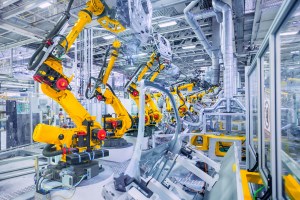The global Industrial Robotics Industry was estimated at US$25.68 billion in 2013 and is expected to reach $US40 billion by 2020.
A new US report released by MillionInsights says growing concerns to reduce operational costs by many manufacturing companies is expected to drive the global market growth.
Industrial robots are designed to control and automate processes including testing, assembly, packaging, welding, product inspection and painting.
Human errors can be minimised, thereby increasing the process efficiency and reliability of the machinery.
The growth of the market can be largely attributed to the adoption of automation through robotics that ensures quality production while meeting market demand as well as the growing demand from small- and medium-scale enterprises in developing countries.
Rising labour costs in many mature economies including US and UK is estimated to drive the global robotics market. Many heavy machinery manufacturers are expected to replace workforce with automation to reduce hiring costs and increase overall production.
Labour costs in China on the rise
Automation involves the installation of advanced technologies and sensors, such as cloud communications and wireless, to monitor and control the entire facility throughout the day.
The prerequisite to comply with governmental regulations and to reduce costs has encouraged the use of industrial robots in heavy industries market.
For example, the average labour costs in China have been rising by nearly 10% yearly. The use of robots in industries has helped to reduced workers idle time by 80% and save more than 50% of the production cost, leading to significant cost savings.
The use of industrial robots for tasks such as welding and sheet handling in heavy industries has also proved the efficiency of the robotic systems in terms reduction in cycle time and raw material wastage.
Implementation of robotic in heavy industry sector is expected to increase the operational flexibility of end users for addressing various product requirements. Robots are used to handle repetitive tasks and are also ideal for multitasking. They are usually deployed in accident prone areas in different production lines.
Largest market share
Based on the application type, the global market has been segmented into industrial welding robots, material handling and assembly line robots. Material handling is expected to account for largest market share owing to increasing demand for efficient handling if heavy machinery under severe working conditions.
These robots can handle heavy payloads and also are very useful in huge machine components which cannot be lifted manually. Welding robots can be attributed as the fastest growing segment and is widely used in automotive industry for arc welding.
On the basis of end user, the industrial robotics market can be segmented into construction machinery, metalworking machinery and other heavy machinery. The metalworking machinery is estimated to have the largest market. This segment involves conventional machine tools and computer numerical control machine manufacturing and is expected to collaborate with robot-machine for efficient and smooth functioning of machinery.
High growth rate
Construction machinery is anticipated to have high growth rate over the forecast period owing to industrialization and globalization.
The other heavy machinery segment includes textile machinery, engineering machinery, F&B machinery, machinery for consumer durables and paper machinery. High costs, Lack of skilled labour and high necessity to improve production processes have led industries to opt for robots as a solution to their production problems.
There are various types of industrial robots, including Cartesian robots, articulated robots, cylindrical robots and SCARA robots.
These robots are used in the heavy machinery industry for different processes, including soldering and welding, assembling and disassembling, handling of materials and processing dispensing, painting, milling, cutting, and other processes.
Rapid evolution of technology has also lead in invention of advanced robots such as collaborative robots. These robots are expected to be much safer to handle and can work along with humans, especially during assembly processes.
Infrastructure projects
Global economic growth, rapid industrial development, and urbanization have led to the development of infrastructure projects and commercial establishments worldwide, particularly in Asia Pacific and the Middle East.
The US is expected to see highest growth rate over the forecast period. This rapid growth can be attributed to emissions that are expected to fuel the market growth, and the legislations regarding energy efficiency especially in the US, as robots are energy efficient and reduce the overall energy consumption and energy costs.
Companies that will continue to play a major role in the global robotics industry include Fanuc, ABB, Yaskawa and Kuka.
Other prominent robotics companies include, Apex Automation and Robotics, Adept Technology, Denso Robotics, Kawasaki Robotics, Epson Robotics, Mitsubishi Electric, Rethink Robotics, TM Robotics, Nachi Robotic Systems and Universal Robots.


